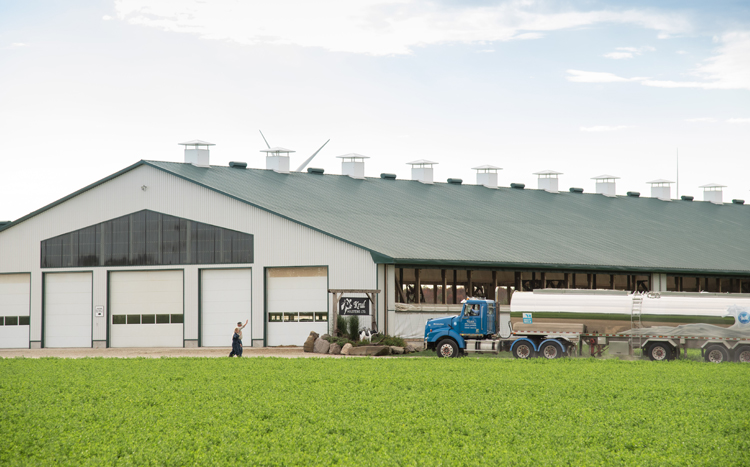IMPROVING ENERGY EFFICIENCY ON ONTARIO DAIRY FARMS


Sustainability is – and has long been – a priority for Ontario dairy farmers. Every generation of farmers looks to build on the improvements made by their predecessors, using research, data and technology to find efficiencies, while minimizing their environmental and energy footprints
The Canadian dairy farm sector is collectively working towards reaching a target of net-zero greenhouse gas emissions by 2050. Dairy Farmers of Ontario is committed to working with dairy farmers across the province to advance on-the-farm solutions in support of this goal.
Three Ontario dairy farmers share how they are leveraging technology to reduce their energy use and environmental footprint on their farms, in support of this larger goal. These are just a few examples that speak to the collective effort of Ontario dairy farmers.
Implementing solar power on the farm
In 2010, Chris Vandenberg, a dairy farmer from Harley, Ontario added 12 10kw solar tracking systems to his family farm to reduce the farm’s energy costs and utilize efficient and sustainable power. This was done as part of a partnership Vandenberg joined with 7 other farmers in the area when they purchased, assembled and installed 12 solar panels.
“We are all responsible for the sustainability of our farms, so when farmers are faced with the crucial moments of making an investment in their farm, it’s important we consider options that will benefit every aspect, including the environment,” says Vandenberg. “We constantly strive to make sure the land provides for us in the present and future. Where we farm is where we live, and we hope that many generations can live here for years to come.”
Solar power has the ability to lower a farm’s energy emissions, and some systems can even be scaled up to produce excess energy which is sold back to the grid. This is an opportunity to support the use of more renewable energy within the local community as well.
Optimizing temperature control for energy efficiency
Ontario dairy farmer Andrew Campbell has focused on farm upgrades that help optimize barn temperature and light, to ensure he is maintaining a comfortable and healthy environment for his cows.
The system, which includes light sensors and temperature control, uses 40-50% of energy needed for fans and consistently monitors the power coming into the barn, optimizing the environment for maximum comfort and efficiency for the herd.
“There are a lot of activities occurring on the farm, including property living and feeding cows – all of which requires a lot of energy. It is important to ensure we are operating sustainably,” says Campbell. “Energy efficiency is very important to help us do this. We want to reduce the amount of external energy we are bringing in. A driver for this is from a cost perspective, but long-term we also know that reducing our energy footprint is a part of a larger puzzle that can help the environment, and the dairy farming industry as a whole.”
Campbell believes that as a dairy farmer you want to make sure the farm is sustainable for the long term and for future generations. Technological upgrades such as these can help farmers ensure longevity and increase productivity in their practices.
Using a heat recovery system to reduce energy use
Bill Gordon, a dairy farmer from Thedford, Ontario, has implemented a heat recovery system to capture and reuse heat produced from their milk cooling system. The heat recovered through this system can be used to temper the water the cows will drink or for various washing and other hot water uses on the farm – meaning less energy is used to create the heat they need.
“Our focus was on trying to improve efficiencies in all aspects. We wanted to be more efficient with our labour, more efficient with our feed and more efficient with our cows,” says Gordon. “We want to be seen as a leader in sustainability to take better care of the land on which we operate”.
What’s next?
Dairy Farmers of Canada states that dairy farmers are well on their way to achieving energy efficiency goals on farm.
While it is encouraging to see the ways in which dairy farmers across the province are embracing new ways of operating to drive efficiency, we know there is still more work to do. Reducing energy use and being more energy efficient is just one way in which Ontario dairy farmers are contributing to Dairy Farmers of Canada’s goal to reach net zero by 2050.
To help our industry reach our net zero goals by 2050, Dairy Farmers of Canada has developed a Best Management Practices Guide to Mitigate Emissions on Dairy Farms to help farmers across the country implement new practices, processes and procedures to become even more energy efficient and reduce the carbon footprint of their farm.
